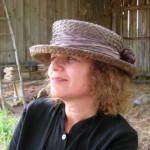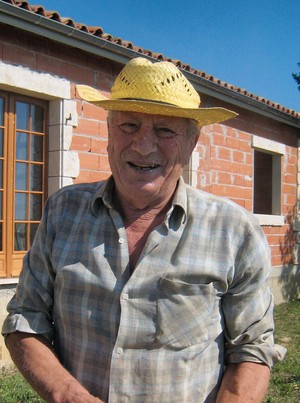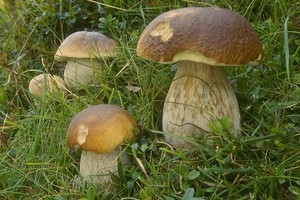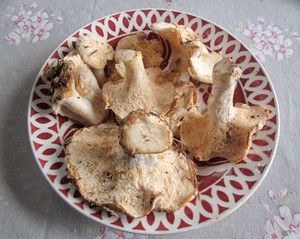Call of the Wild in Gascony


- SUBSCRIBE
- ALREADY SUBSCRIBED?
BECOME A BONJOUR PARIS MEMBER
Gain full access to our collection of over 5,000 articles and bring the City of Light into your life. Just 60 USD per year.
Find out why you should become a member here.
Sign in
Fill in your credentials below.
 This past November I decided to get in touch with my inner hunter gatherer and went mushroom hunting with a friend of mine, Gelindo Muccignato, a man greatly respected in his three beloved fields of endeavor – masonry, gardening and mushroom hunting. At 82, Gelindo looks like a French movie star, from the golden age of cinema and is just as charming, though he’s Italian by birth. Quite often I would find baskets of freshly picked mushrooms on my doorstep in the morning and I knew he was leaving me tokens of affection. As an outsider for many years, Gelindo has a soft spot for other outsiders and not only am I an American, I’m a vegetarian as well – living in a fois gras culture. I decided that if I wanted to learn how to forage I had to learn from an expert.
This past November I decided to get in touch with my inner hunter gatherer and went mushroom hunting with a friend of mine, Gelindo Muccignato, a man greatly respected in his three beloved fields of endeavor – masonry, gardening and mushroom hunting. At 82, Gelindo looks like a French movie star, from the golden age of cinema and is just as charming, though he’s Italian by birth. Quite often I would find baskets of freshly picked mushrooms on my doorstep in the morning and I knew he was leaving me tokens of affection. As an outsider for many years, Gelindo has a soft spot for other outsiders and not only am I an American, I’m a vegetarian as well – living in a fois gras culture. I decided that if I wanted to learn how to forage I had to learn from an expert.
Early one morning I drove from my very small village of Ayzieu a half hour north, down country roads where sometimes you don’t see another car for hours. I passed the small church in Gabarret that Gelindo had mentioned and turned right just after the sign for Castelnau d’Auzan. I met Gelindo along the side of a deserted road, across from the third, white and black name post on the left. I parked my car and climbed into his old, faded blue Deux Chevaux with a sigh of relief at having found him. Gelindo speaks a patois of Italian, French and old Gascon that can be indecipherable to the unpracticed ear and I was happy I’d understood his throaty, sharply fired directions on the telephone the night before.
 Mushroom hunters have their own secret places that they guard protectively, sometimes with a shotgun. I had just read an article in the Herald Tribune about a man who shot to death another man found crossing his prize truffle reserve, so I was surprised I wasn’t blindfolded, but even in the broad light of day I wouldn’t have been able to find my way back into the deep woods we were now penetrating. We drove another fifteen minutes down a leaf covered lane, in between fallen branches and rusty bracken ferns. He turned the engine off. We got out of the car and closed the doors behind us. All we could hear was the magical sound of the forest, the crackle of dried leaves yet to fall and a few notes of morning bird song. I carried a large wicker basket as we walked for hours with our heads down using long thin sticks cut from branches hidden in the thick leaf cover beneath our feet. I followed closely behind Gelindo, my small footprints filling his larger ones. Every so often he would push aside a pile of moldy leaves and point to a prize which I would carefully tug from the rich compost of the forest floor. All of a sudden I looked up, startled by another man’s voice, my heart pounding. “Bonjour”, he said to us and we said, “Bonjour” right back out of habit. Gelindo and the man made eye contact for the briefest of moments, then the man scurried past us silently and disappeared. I took my cue from Gelindo and bent my head down, once again, grateful that only a pleasant salutation had been exchanged.
Mushroom hunters have their own secret places that they guard protectively, sometimes with a shotgun. I had just read an article in the Herald Tribune about a man who shot to death another man found crossing his prize truffle reserve, so I was surprised I wasn’t blindfolded, but even in the broad light of day I wouldn’t have been able to find my way back into the deep woods we were now penetrating. We drove another fifteen minutes down a leaf covered lane, in between fallen branches and rusty bracken ferns. He turned the engine off. We got out of the car and closed the doors behind us. All we could hear was the magical sound of the forest, the crackle of dried leaves yet to fall and a few notes of morning bird song. I carried a large wicker basket as we walked for hours with our heads down using long thin sticks cut from branches hidden in the thick leaf cover beneath our feet. I followed closely behind Gelindo, my small footprints filling his larger ones. Every so often he would push aside a pile of moldy leaves and point to a prize which I would carefully tug from the rich compost of the forest floor. All of a sudden I looked up, startled by another man’s voice, my heart pounding. “Bonjour”, he said to us and we said, “Bonjour” right back out of habit. Gelindo and the man made eye contact for the briefest of moments, then the man scurried past us silently and disappeared. I took my cue from Gelindo and bent my head down, once again, grateful that only a pleasant salutation had been exchanged.
Discovering the telltale crown tops of cèpes, porcini mushrooms, growing wild in the forest, hidden amongst many different varieties, for me, was an ancient form of alchemy, zen made manifest. Precious moments like these made me more intensely alive and connected to those people who actually hunted and gathered because they had to to stay alive. In the mild, wet climate of Gacony I was reenacting foraging skills used for centuries and I was humbled. Though scientific research wasn’t available hundreds of years ago, fungi were already known as superfoods by the ancient Chinese. A wild harvest or sun-dried exotics eaten on a regular basis can boost the immune system, are full of anti-oxidents and play a crucial role in bone and heart health. However, I need to toss in a few words of caution amidst my musings – It takes an expert mycologist (fungi specialist) to tell the difference between edible and poisonous mushrooms. Do not go mushroom hunting without having taken a class, followed an expert like I did or both. Eating the wrong mushrooms can make you violently ill and cause death. Fortunately, in France you can take any mushroom to any pharmacy and they will tell you if what you have picked is safe to eat.
 We arrived back at my house before noon with wet feet, a full basket of beautiful, fresh mushrooms and hearty appetites. I sautéed thin slices of mushrooms in olive oil and garlic, then tossed them into a bubbling omelette with a sprinkling of fleur de sel. With a green salad, chunks of crusty bread and a bottle of Bordeaux we sat down to the perfect meal – good food, good wine and even better company.
We arrived back at my house before noon with wet feet, a full basket of beautiful, fresh mushrooms and hearty appetites. I sautéed thin slices of mushrooms in olive oil and garlic, then tossed them into a bubbling omelette with a sprinkling of fleur de sel. With a green salad, chunks of crusty bread and a bottle of Bordeaux we sat down to the perfect meal – good food, good wine and even better company.
Note – Article 547 of the Code Civil stipulates that mushrooms belong to the owner of the land where they grow. Each commune has the right to decide whether picking is allowed, what quantities can be picked, what fees can be charged or forbid picking altogether. Mushrooms must be a certain size so they have an opportunity to release their spores. Tools are forbidden, except knives and the mushrooms must be carried in a wicker basket to let the spores fall out and propagate.
More in mushroom, mushroom hunting


